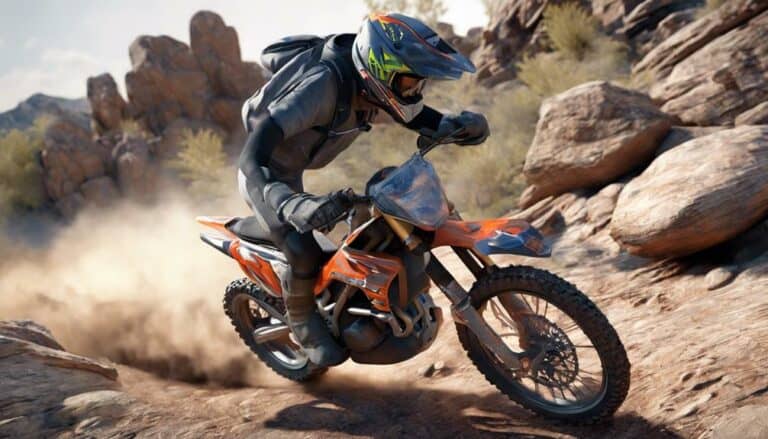While you may think that body positioning is just a minor detail, it can greatly impact your stability and maneuverability when tackling rough terrain.
Picture yourself cruising through rocky paths or steep descents; your body's positioning can make all the difference between a smooth ride and a bumpy one.
But how exactly does it influence your control over the bike in such challenging conditions?
Stay tuned to uncover the secrets behind mastering rugged terrains through strategic body positioning.
Key Takeaways
- Body positioning optimizes stability and control on rugged terrain.
- Proper weight distribution enhances maneuverability and traction.
- Adjusting posture increases control and prevents accidents.
- Mastering body positioning is crucial for a smooth off-road cycling experience.
Importance of Body Positioning in Rugged Terrain
In traversing rugged terrain, the importance of precise body positioning can't be overemphasized. When riding uphill terrain on a mountain bike, your body position plays a critical role in maintaining stability and control. By distributing your weight correctly between the front wheel and the rear wheel, you can optimize traction and guarantee better handling over challenging obstacles like rocks and roots. To maintain balance and control, it's essential to keep your body low with knees bent and hips positioned over the saddle. This ready position allows you to react quickly to changes in the terrain and adjust your movements accordingly.
Proper body positioning not only enhances stability but also improves your ability to maneuver through rough sections with confidence. By staying focused on your body's alignment and actively adjusting it to suit the terrain, you can effectively navigate potholes and maintain control over your mountain bike. Remember, your body position is the key to unleashing the full potential of your ride on rugged terrain.
Techniques for Improved Stability
Optimizing your stability on rugged terrain involves mastering specific techniques that enhance control and maneuverability over challenging obstacles. Proper body positioning plays a key role in achieving this. By distributing your weight evenly and maintaining a low center of gravity, you can navigate rough terrain more effectively. Adjusting your body position according to the terrain type is key to maximizing stability and handling. This not only reduces the risk of accidents but also enhances your overall riding experience.
| Technique | Description | Benefit |
|---|---|---|
| Body Position | Adjusting posture for best weight distribution | Improved stability and control |
| Weight Distribution | Spreading weight evenly over the bike | Enhanced maneuverability |
| Center of Gravity | Keeping the center of gravity low | Better handling over obstacles |
Maneuverability Tips for Rough Terrain
To enhance your maneuverability on rough terrain, mastering proper body positioning techniques is essential for achieving ideal control and stability. When traversing through challenging landscapes, maintaining a balanced weight distribution between your wheels is critical.
By adjusting your body position according to the type of rough terrain you encounter, you can improve your handling and reduce the likelihood of accidents. Leaning into obstacles and corners with the correct body posture can greatly increase traction and control, allowing you to tackle the terrain more effectively.
It's essential to practice various body positions on rough terrain to develop the skills necessary for best maneuverability and stability. Remember, the way you position your body directly impacts your ability to control your bike in challenging conditions.
Impact of Body Position on Control
Maximizing control and stability on rugged terrain heavily relies on mastering proper body positioning techniques. When considering the impact of body position on control, several key factors come into play:
- Weight Distribution: By shifting your body weight appropriately, you can balance the bike and prevent it from tipping over on uneven terrain.
- Center of Gravity: Keeping your center of gravity low through correct body positioning enhances stability, making it easier to handle the bike over obstacles.
- Obstacle Navigation: Adjusting your body position allows you to effectively steer the bike through challenging obstacles and rough terrain, improving overall control and maneuverability.
Mastering Rugged Terrain Riding
Mastering rugged terrain riding requires a precise understanding and application of advanced body positioning techniques to navigate challenging obstacles with control and stability. Proper body positioning plays a critical role in enhancing stability by effectively distributing weight between the wheels on rugged terrain.
By maintaining a low center of gravity through strategic body positioning, you can greatly increase control and maneuverability over rough surfaces. It's essential to adjust your body position based on the type of terrain you're riding on to successfully navigate obstacles such as rocks, roots, and ruts.
Leaning into turns and shifting your weight appropriately will aid in maintaining traction on challenging surfaces, ensuring a smooth and safe riding experience. Skillfully adjusting your body position throughout your ride is vital for adapting to changing terrain conditions and obstacles, ultimately leading to a more enjoyable and controlled off-road cycling experience.
Conclusion
To sum up, mastering proper body positioning is vital for enhancing stability and maneuverability when riding through rugged terrain. By maintaining the correct weight distribution and posture, you can navigate obstacles with ease and control.
Remember, one small adjustment in your body positioning can make a world of difference in your ride. So, practice diligently and soon you'll be tackling rugged terrain like a pro, effortlessly gliding over obstacles as if they were mere grains of sand.

